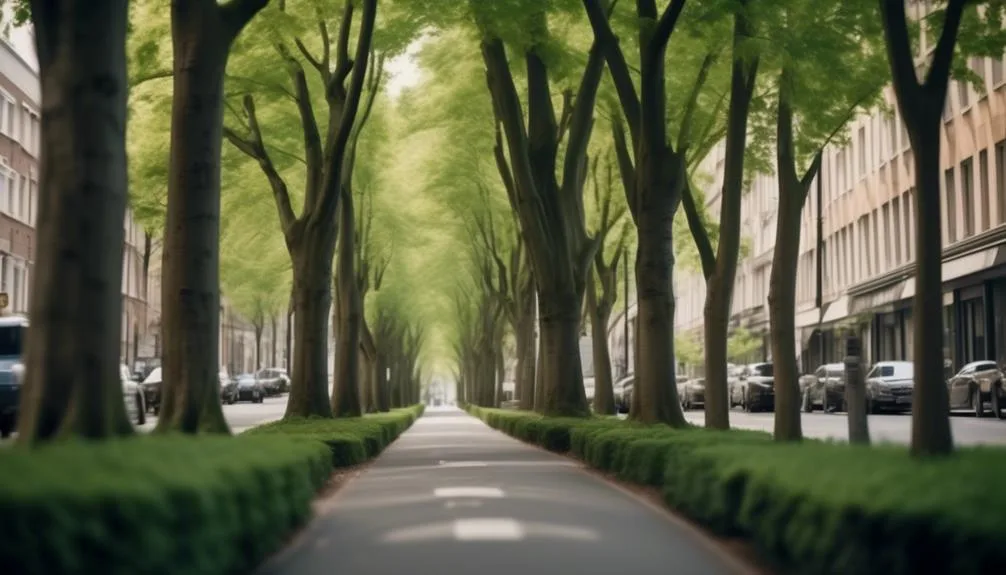Wondering if beech trees are suitable for planting on city streets? These smooth-barked trees with lush foliage are being considered for adding greenery to urban areas.
However, before deciding, it's important to weigh the pros and cons. Factors like maintenance and aesthetic appeal need to be considered.
Determining if beech trees are the right choice for street planting may not be straightforward, but understanding the considerations can help you make an informed decision.
Advantages of Beech Trees for Street Planting
Beech trees are an excellent choice for street planting due to their stately appearance, low maintenance requirements, and ability to thrive in urban environments.
One of the key advantages of using beech trees for street planting is their aesthetic appeal. Their majestic, spreading canopy and smooth gray bark add a touch of elegance to urban landscapes.
Additionally, beech trees offer environmental benefits such as air purification and providing habitat for birds and other wildlife. Their dense foliage also provides shade, reducing the urban heat island effect.
Furthermore, beech trees are resilient and can withstand various urban conditions, making them a sustainable choice for street planting.
Considerations for Planting Beech Trees on Streets
When considering the planting of beech trees on streets, it's crucial to assess the soil and environmental conditions to ensure their successful growth and longevity. Beech trees have shallow, sensitive roots that can be easily damaged by compacted soil and urban pollution. Prior to planting, evaluate the soil for proper drainage and aeration to prevent root damage.
Urban pollution, such as vehicle emissions and industrial byproducts, can also affect the health of beech trees. It's important to select tree species that are tolerant of these conditions and to implement measures to mitigate the impact of urban pollution, such as regular maintenance and appropriate irrigation.
Maintenance Requirements for Beech Trees on Streets
To maintain healthy beech trees on urban streets, regular pruning and monitoring for signs of stress are essential. Beech trees require a maintenance schedule to ensure their longevity and aesthetic appeal. The following table outlines basic pruning techniques and maintenance considerations.
| Maintenance Task | Frequency | Description |
|---|---|---|
| Pruning | Every 3-5 years | Remove dead, diseased, or damaged branches. |
| Monitoring | Annually | Check for signs of stress, disease, or pest infestations. |
| Mulching | Bi-annually | Maintain a 2-4 inch layer of mulch around the base of the tree. |
Potential Challenges of Planting Beech Trees on Streets
Planting beech trees on urban streets can present several challenges that require careful consideration and planning to ensure their successful establishment and growth.
Urban environments pose unique obstacles for tree growth, and beech trees are no exception. One of the primary challenges is the limited space available for root expansion, which can lead to restricted growth and stability issues.
Additionally, urban pollution, compacted soil, and restricted access to water can all hinder the health and development of beech trees. Furthermore, the presence of overhead wires and buildings can impact sunlight exposure and lead to irregular growth patterns.
It's essential to address these challenges by selecting appropriate beech tree species, implementing proper soil management techniques, and providing adequate irrigation and maintenance.
Conclusion: Suitability of Beech Trees for Street Planting
Despite the challenges presented by urban environments, beech trees can thrive on streets when proper care and planning are implemented.
Their root systems, when managed effectively, can minimize infrastructure impact, making them suitable for street planting.
Additionally, beech trees offer aesthetic appeal and can enhance community engagement. The dense foliage and elegant form of beech trees contribute to the visual allure of urban streets, creating a pleasant environment for residents and visitors.
Furthermore, the presence of these trees encourages community members to engage in activities such as tree care and environmental stewardship, fostering a sense of pride and ownership.
With the right maintenance and consideration for their surroundings, beech trees can't only survive but also flourish on urban streets, providing numerous benefits to the community and the environment.
Conclusion
Considering the beauty, resilience, and low maintenance requirements of beech trees, they emerge as a strong candidate for street planting. However, careful attention to space and soil conditions is essential. Thoughtful planning can harness the benefits of beech trees, adding charm to urban streets and fostering a healthier environment.
Is the inclusion of beech trees in street planting a step towards sustainable and appealing urban landscapes?

My interest in trees started when I first saw the giant sequoias in Yosemite.
I was a teenager then, and I remember thinking, “I need to learn more about this.”
That moment stuck with me.
A few years later, I went on to study forestry at Michigan Tech.
Since graduating, I’ve worked in a mix of hands-on tree care and community education.
I’ve spent over ten years helping people understand how to plant, maintain, and protect the trees in their neighborhoods.
I don’t see trees as just part of the landscape.
They are living things that make a real difference in our daily lives.
